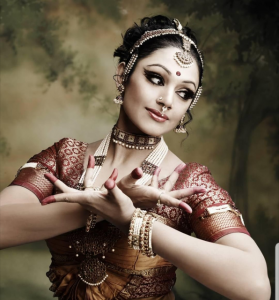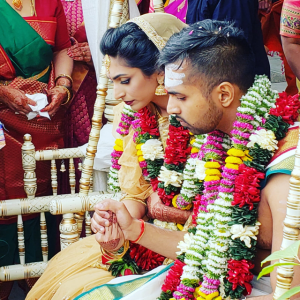
The crowd began to stream in quite early at the San Jose Center of the Performing Arts, the hallways soon a chattering buzz of anticipation. They had come to witness renowned actress and danseuse Shobana’s latest production, Trance – Dance of Drums.
Nestled well and comfortably in their seats, the performance commenced precisely at the appointed time. Two mesmerizing hours later, the enthralled audience rose to its feet in generous and sustained applause. The masterful performance had impressed even the most seasoned of the cognoscenti to the very core.
The word trance can suggest several nuances, but the hypnotic rhythms and sounds that strung through the evening’s many acts transformed the stage into a space of swirling energy. The themes were chosen for their universal import, starting with the Dasha Mahavidyas, the 10 Tantric wisdom goddesses. This was no dainty ballroom dance, but a startling, unsettling, dynamic immersion into the fathomless energy of Mahakali, the Goddess who is the devourer of time.
Vanquishing the ignorance which masquerades as evil with her sword, challenging all limiting conventions, Kali stormed the stage with an electric tension, the haunting background score of the Kaapi raga heightening the charged atmosphere. Depicted also as the South Indian goddess Mariamma, Kali’s inebriated sway and dominance of stage was a searingly authentic portrayal of the inscrutable, often implacable aspects of Reality. No sooner had it come to a peak of intensity though, than the tempo turned swiftly into one of Kali’s reassuring protection and grace. The soothing notes of Nilambari and Shankarabharanam now accompanied the dancers’ exquisite hand mudras, reminiscent of blossoming lotus flowers. The audience by now had its appetite whetted.
If the first act saw a supine Lord Shiva struggle to catch a glimpse of the Goddess’s crimson feet, the next act showed the Lord coming into his own, first in eternal play with Kali and a host of yoginis. Shiva as Tripurantaka, destroyer of the three citadels of evil, emerged ultimately as Nataraja, Lord of cosmic dance and rhythm. A glorious sequence of poses culminating in Nataraja’s cosmic pose with raised foot will remain imprinted in memory.
God and Goddess acknowledged, the next act celebrated the divine romance of Radha and Krishna, as immortalized in the lyrical poem, Lalita Lavanga. The infatuating environment of the spring season, Radha’s pining for Krishna even as he frolicked in the forest with the other smitten maids of Vrindavan, followed by Krishna’s atonement and subsequent charming and entrancing of Radha…all of these classical themes left the audience in rapture.
The next segments of the show, we were now informed, would highlight interfaith themes of religious harmony, and especially of lesser acknowledged yet great women mystics from various traditions. First in sequence was the story of the Buddha. This was much like an abridged version of Edwin Arnold’s classic ‘Light of Asia’, enlivened with form and movement, chants and voice, color and light. Particularly poignant was the episode of the prince Siddhartha’s renunciation, and his brave surmounting of the dragons and dangers of the spiritual path. The steps and musical scores suggested a distinctive Asian influence, including hypnotic chants of the Tibetan and Japanese mantras of compassion and surrender. The dance itself seemed to melt into a living stream of compassion.
The story of Bibi Nachiar, the Muslim princess and exemplary devotee of Lord Krishna, was depicted next, in a flowing fusion of Sufi and Bharatanatyam dance styles. The devotional element was highlighted by some soulful Sufi Qawwali music and the strains of the Carnatic Rangapura Vihara in equal and delightful measure. The choreography, in addition, proved to be an unforgettable visual treat.
No less impactful was the next piece about Mary of Magdala, the ‘apostle of apostles’, and her tale of great devotion to the prophet of Nazareth. Set against a backdrop of Mediterranean visuals and the life of Jesus, the dancers did a stellar job of bringing home the high spiritual stature of Mary Magdalene. Magdalene’s pure devotion made her the first person to whom the Lord Christ revealed himself after his resurrection. Through these remarkable stories, the audience received a sense for the universality of aspirations to Truth, and its genuine manifestations across varieties of religious practice.
The crowning highlight of the evening was the entrancing ‘Dance of Drums’, a celebration of the pure potency of sound. The audience was treated to a panorama of different percussion traditions, with Shobana’s astonishing drumming talents providing further confirmation of her astonishing versatility. For a few charming minutes, she invited them to keep step with her captivating percussion chants from the various regional styles of India, and across the world, getting everyone to partake in the flow.
The rest of the dance cast were no less impressive. The live orchestra comprising Prithvi Chandrasekhar on the keyboard and Anantha R. Krishnan for percussion provided excellent support, and were good enough to host an evening on their own. The jugalbandi playoff with the live orchestra, as well as the delightful interweaving of dance snippets and styles from around the world was a high point. This was truly the dance of sound competing for honors with the sound of dance, the creative expressions of these artistes of extraordinary endowment. The final piece was an energetically paced yet soul stirring rendition of the Hanuman Chalisa, an offering to herald ultimate auspiciousness.
The harmonious blending of visual imagery and vocals, electronic embellishments and traditional styles was a feat of perfect orchestration for the evening as a whole. Above all, Shobana had, with her vivid stage presence and genuine passion, succeeded in communicating something of the esoteric essence that underlies all true art. Hers was indeed, in the beautiful words of Tagore, the dance that is ecstatic meditation in the still center of movement.

